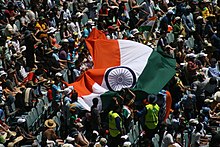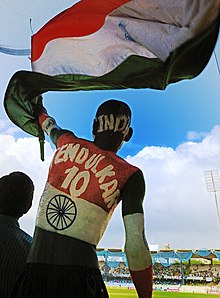Fan following
Main article: Cricket in India

Supporters of the Indian cricket team wave the Indian flag during match between India and Australia at the Melbourne Cricket Ground.
There have been a number of official fan groups that have been formed over the years, including the Swami Army or Bharat Army, the Indian equivalent of the Barmy Army, that were very active in their support when India toured Australia in 2003/2004. They are known to attribute a number of popular Indian songs to the cricket team.[81]

Sudhir Kumar Chaudhary a fan of the Indian Cricket team, travels to all Indian home games with his body painted as the Indian Flag.
However, there are downsides to having such a cricket-loving population. Many Indians hold cricket very close to their hearts and losses are not received well by the Indian population. In some cases, particularly after losses to Pakistan or after a long string of weak performances, there have been reports of player effigies being burnt in the streets and vandalism of player homes.[83] In many cases, players have come under intense attention from the media for negative reasons, this has been considered as one of the reasons for Sourav Ganguly being left out of the Indian team. At times, when a match is surrounded by controversy, it has resulted in a debacle. For example, when India slid to defeat against Australia at Brabourne Stadium in 1969, fans began throwing stones and bottles onto the field as well as setting fire to the stands, before laying siege to the Australian dressing rooms. During the same tour, a stampede occurred at Eden Gardens when tickets were oversold and India fell to another loss; the Australian team bus was later stoned with bricks.[84] A similar event occurred during the 1996 Cricket World Cup, where India were losing the semi-final to Sri Lanka at Eden Gardens. In this case, the fan behaviour was directed at the Indian team in disappointment at their lacklustre performance. An armed guard had to be placed at the home of captain Mohammad Azharuddin to ensure his safety.[84] Indian fans have also been passionate in their following of Sachin Tendulkar, who has been commonly thought of as one of the best batsmen in the world. Glorified for the bulk of his career, a riot occurred in early 1999 in a Test against Pakistan at Eden Gardens after a collision with Pakistani paceman Shoaib Akhtar saw him run out, forcing police to eject spectators and the game to be played in an empty stadium. Although in 2006, a string of low scores resulted in Tendulkar being booed by the Mumbai crowd when he got out against England[85]
Often, fans engage in protests regarding players if they believe that regionalism has affected selection, or because of regional partisan support for local players. In 2005, when Sourav Ganguly was dropped due to lack of form, Ganguly's home state of West Bengal erupted in protests.[86] India later played a match against South Africa in Kolkata, West Bengal. The Indian team was booed by the Bengali crowd who supported South Africa instead of India in response to Ganguly's dropping. Similar regional divisions in India regarding selection have also caused protests against the team, with political activists from the regional Kalinga Kamgar Sena party in Odisha disrupting the arrival of the team in Cuttack for an ODI over the lack of a local player in the team, with one activist manhandling coach Greg Chappell.[87] Similar treatment was handed to India's Marathi captain Sunil Gavaskar in the 1980s by Bengali crowds, with consecutive Tests in Calcutta requiring police intervention due to crowd rioting.[85]
However, it should be noted that a successful string of results, victories against arch-rivals Pakistan or victory in major tournaments such as the World Cup are greeted with particular ecstasy from the Indian fans.[88]
Indian women's cricket team

Members of the Indian cricket team before a Women's Cricket World Cup game in Sydney
Main article: Indian women's cricket team
The Indian women's cricket team has a much lower profile than the
men's team. For all national women's cricket teams, the female players
are paid much less their male counterparts, and the women's teams do not
receive as much popular support or recognition as the men's team. The
women's teams also have a less packed schedule compared to men's teams
and play fewer matches. The Indian women's cricket team played its first
Test match in 1976/7, when they drew with the West Indies in a six-match series.The Women's Cricket World Cup was held in India in 1978 and featured 4 teams. Despite this, India failed to win either of their two matches. Their next appearance in the Test and ODI circuit was against Australia in 1984, in which the Test series was tied but the ODI series was lost in a humiliating whitewash.
The Indian women's cricket team has since picked up some form, reaching the finals in the last World Cup, but then losing to Australia. The Women's Asia Cup of 2005–06 was won by India, who beat Sri Lanka in the final. They also beat the West Indies in the 2004–05 season, winning the 5 ODI series 5–0. This year the Indian women's team lost to English women's team 4–0 in an ODI Series but beat them in the Twenty20 International and 1–0 in the Test series.
No comments:
Post a Comment